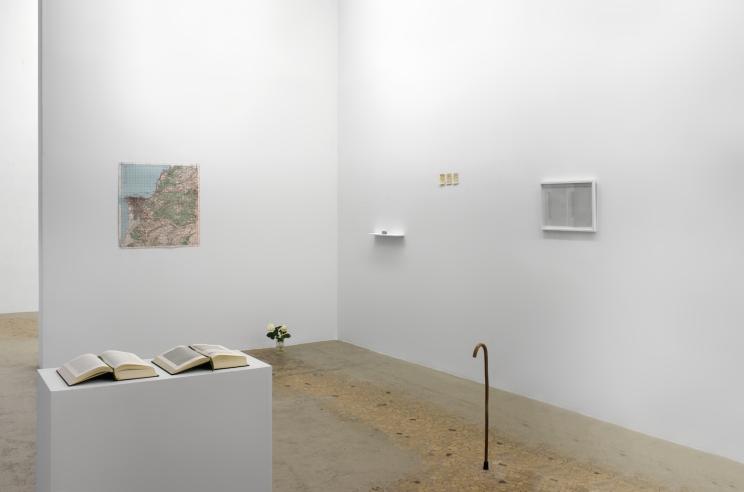sun, romance and destruction
.
ENGLISH BELOW
SUN, ROMANCE AND DESTRUCTION
TEXTE DE LÉA BISMUTH, COMMISSAIRE D'EXPOSITION INDÉPENDANTE ET CRITIQUE D'ART, POUR L'EXPOSITION SUN, ROMANCE AND DESTRUCTION, AVEC
STÉPHANIE SAADÉ, CHARBEL-JOSEPH H.BOUTROS AND PAUL HAGE BOUTROS, GALERIE ANNE BARRAULT, PARIS, 2015.
“
« Mais qu’en est-il de nous quand, désintoxiqués, nous apprenons ce que nous sommes ? »
Georges Bataille, "L’Expérience intérieure".
Une nouvelle génération d’artistes émerge sur la scène libanaise contemporaine, des artistes capables de réconcilier l’intime et le politique avec force
et — osons le mot— poésie. Il y a quelques jours, à la radio, j’entendais Marguerite Duras parler de la charge révolutionnaire de la poésie. Nous
oublions souvent que ce sont là les deux branches d’un même arbre. Et ces artistes libanais s’y accrochent. Bien sûr, l’histoire politique du Liban est à
prendre en compte. Bien sûr il y a Walid Raad, la force des archives pour dire le Temps contre la disparition. Bien sûr, le Liban n’a vécu que la guerre
depuis maintenant 30 ans. Mais Charbel-joseph H. Boutros, Paul Hage Boutros et Stéphanie Saadé ne tournent pas le dos à cette histoire-là : au
contraire, ils la prennent en charge dans leur intimité, dans leurs corps, dans leurs confessions, dans leur sommeil, et leurs expériences intérieures. Et
si je parle d’expérience intérieure, c’est en pensant à Georges Bataille, qui écrit ce livre si dense, en France pendant la Seconde Guerre Mondiale, à un
moment où il ne voit qu’obscurité et abîme du sens.
Ces démarches possèdent une force radicale. La réduction minimale héritière de la tradition conceptuelle est ici toujours engagée dans une quête
sensible, attachée aux potentiels de fiction et ne négligeant jamais la « 1ère personne ». Ces œuvres ne sont pas le résultat de protocoles froids. Elles
sont en elles-mêmes comme chargées d’électricité, et en deviennent des concepts remplis à craquer, remplis de soleil, de nuit, d’énigme, de
mélancolie, de nostalgie ; mais aussi d’artifices, de gestes si précis qu’ils ne sont jamais symboles étouffants.
Ces artistes me rappellent que la délicatesse est une conquête. L’élégance aussi. Ces mots ne sont pas vides. Ils sont avant tout le résultat d’un
engagement de l’être qui rayonne autour de lui, résolument ouvert sur l’ouvert, ouvert sur l’action, sur ce qui doit être dit ici et maintenant, et prendre
forme ici et maintenant.
Deux roses cohabitent dans le même vase, l’une artificielle, l’autre naturelle.
Une chaîne aux maillons incompatibles reste néanmoins une chaîne.
Les Confessions de Rousseau sont désormais parcellaires.
Une clé plantée dans un tas de terre incarne le mal du pays.
Toutes les pensées ont été effacées.
Des téléphones sonnent. Sans réponse.
Le secret. Le sang. L’amour.
L’obscurité lumineuse.
Le soleil de Beyrouth s’arrêtera-t-il un jour de briller ?
.
SUN, ROMANCE AND DESTRUCTION
TEXT BY LÉA BISMUTH, INDEPENDANT CURATOR AND ART CRITIC, FOR THE EXHIBITION SUN, ROMANCE AND DESTRUCTION, WITH STÉPHANIE SAADÉ,
CHARBEL-JOSEPH H.BOUTROS AND PAUL HAGE BOUTROS, GALERIE ANNE BARRAULT, PARIS, 2015.
“But what about us when, detoxified, we learn what we are?”
Georges Bataille, "L’Expérience Intérieure".
A new generation of artists emerges on the contemporary Lebanese scene, artists able to reconcile what is intimate with what is political, with strength
and –let us not fear the word- poetry.
A few days ago, on the radio, I was listening to Marguerite Duras talking about the revolutionary impact of poetry.
We often forget that they are the two branches of the same tree. And these Lebanese artists cling to it. Of course, the political history of Lebanon is to
be considered. Of course there is Walid Raad, the power of archives to tell the Time against disappearance. Of course Lebanon has known nothing but
the war for now 30 years. But Charbel-Joseph H.Boutros, Paul Hage Boutros and Stéphanie Saadé do not ignore this history: on the contrary, they
assume it in their private lives, in their bodies, in their confessions, in their sleeps, in their inner experiences. And if I speak of inner experience, I think of
Georges Bataille, who writes this book, so dense, in France, during the Second World War, when he only sees darkness and a meaningless abyss.
These approaches have a radical strength. The minimalist reduction issued from the conceptual tradition is here always engaged in a sensitive quest,
linked to the potentials of fiction, without ever neglecting the “I”. These works are not the result of cold protocols. In themselves they are as if charged
with electricity, and so become concepts, filled with sun, night, enigma, sadness, nostalgia: but also with artifices, skills so precise that they are never
stifling symbols.
These artists remind me that delicacy is a conquest, so is elegance. These are not empty words. They are primarily the result of the engagement of
someone who beams on others, decidedly open to openness, open to action, to what must be said there and then, and take shape there and then.
Two roses are in the same vase; one is artificial, the other is natural.
A chain with incompatible rings is nevertheless still a chain.
The Confessions of Rousseau are, from now on, incomplete.
A key stuck in a heap of earth embodies homesickness.
Every thought has been deleted.
Phones ring. No answer.
Secret. Blood. Love.
Bright darkness.
Will one day the sun of Beirut stop shining?

Exhibition view of Sun, Romance and Destruction, galerie Anne Barrault, Paris, 2015.